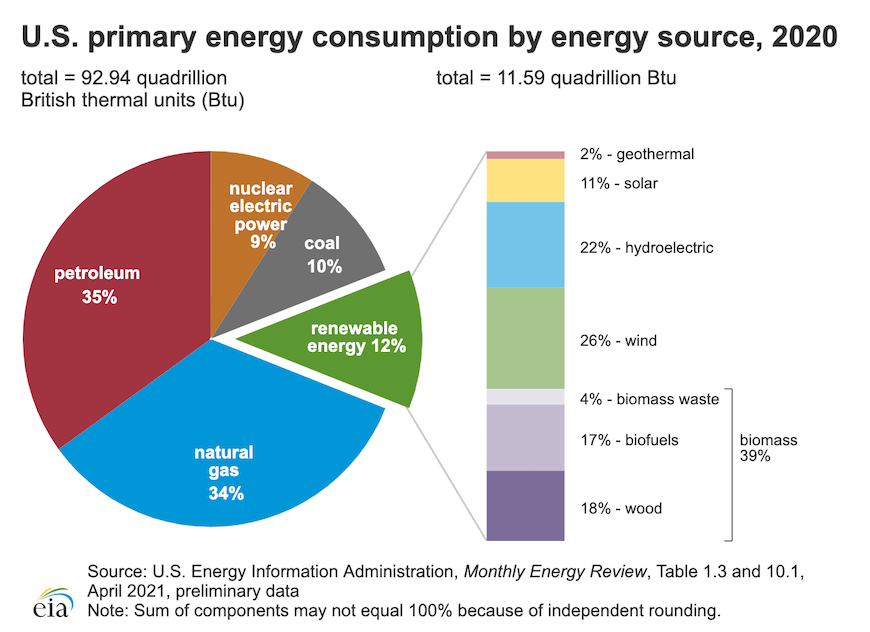
Sources of energy
From the industrial revolution, we consume more and more. First, we used mainly coal and with heating, we made steam engines. The trend did not change for decades, and yet, we still use mainly non-renewable sources. The demand for energy sources rises exponentially. With the higher demand that cannot be supplied only with renewable energy, we caused two problems:
However, zero waste looks like an impossible solution to this problem, so in this article, we focus on the energy source types and examples.

Source: https://www.eia.gov/energyexplained/us-energy-facts/
Non-renewable energy sources
What are the non-renewable sources of energy? The so-called fossil fuels are facing a decrease in their amount every year - so we have to use them wisely. You can help with saving energy at work and at home too.
Petroleum
Petroleum (or crude oil) is made of mixtures of hydrocarbons. Pressure and heat created tiny layers from dead animals and plants. This process took millions of years.
Mostly gasoline and other fuel types are made from petroleum.
Natural gas
The formation of natural gas is similar to petroleum, but it is (as its name shows) in a gaseous state. The use of natural gas:
- generating electricity,
- heating,
- fuel for transportation.
Read more about natural gas.
Coal
Coal is another fossil fuel that is formed from organisms that lived a long ago. We use it for:
- cement, tars, and foam production,
- heating,
- in the medical sector.
Read more about coal and its environmental impacts.
Nuclear energy
Nuclear energy is one way to go carbon neutral. Nuclear power is the second-largest source of low-carbon electricity, and there are two types of countries:
- the ones who believe that safe nuclear power plants are a good way to avoid greenhouse gas emissions
- and the others who reduce their nuclear energy.
Nuclear waste can cause a big problem and might be only a bridge solution on the way to renewable energy.
Renewable energy sources
If you are interested in this topic, read more about alternative energy sources pros and cons.
Solar energy
With solar panels, we can collect the energy coming from the sun and use it. Solar energy can be seasonal, and until we can not store it properly, there is a high chance that we cannot cover our energy needs with just solar power.
Read more about solar energy.
Wind energy
Wind energy is one of the oldest renewable energy sources we use - but it has the most disadvantages too. The wind is not blowing all the time, and a wind turbine requests a large area to be efficient. Establishing wind power farms can hurt the environment: it is not only dangerous to birds but can harm the local habitats too. Yet, wind energy is the cheapest renewable energy in many countries.
Read more about wind energy.
Hydropower
It works like a wind turbine, but the generator’s turbine is spun by fast-moving water instead of wind. Small hydroelectric plants and mega-dams produce electricity by the power of water.
It is effective in countries where rivers are flowing fast.
Geothermal energy
Geothermal energy is considered a green energy source, but it has risks: for example, drilling into the ground can cause an earthquake in the area.
Drilling into the Earth releases hot water or even steam that can be used as a type of energy.
Cost of energy sources
Wikipedia shows the difference in fossil fuel prices. It seems like renewable energy is cheaper - but the establishment of the technology that is able to produce electricity from green energy at home is not included in the price.
Some examples:
- gas/oil combined cycle power plant - $1000/kW
- geothermal - $2800/kW (2019)
- coal (with SO2 and NOx controls)- $3500–3800/kW
- advanced nuclear - $6000/kW (2019)
- onshore wind - $1600/kW (2019)
Future of energy sources
In the future we will most likely use renewable energy sources – the biggest change compared to today’s energy usage is that nowadays we cannot store energy efficiently. Of course, you could sell the energy you produce, and maybe that is the future. Instead of one big energy supplier, small communities will be formed to share energy.
Decarbonization has a key role in the future, but countries are making progress. For example, in the European Union, the Green Deal is getting more and more serious - and the participating countries have to follow the deal’s guidelines.
Conclusion: The importance of green energy
Not only because we are emptying our non-renewable energy resources, but also because of the threatening global warming we have to switch to renewable energy and decrease our waste.
This journey will take decades, and we have to accept that at some point, we have to use natural gas or nuclear energy before we are able to use only the power of the Sun or our oceans.
